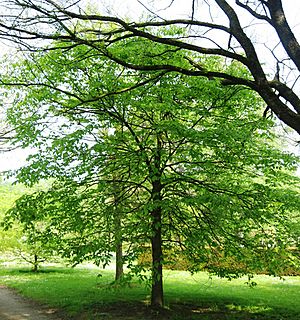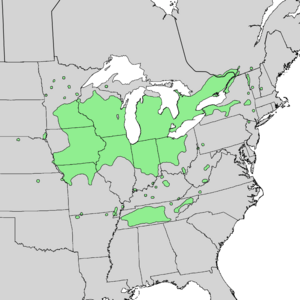Rock elm facts for kids
Quick facts for kids Rock elm |
|
|---|---|
 |
|
| Rock elm, Meise. | |
| Conservation status | |
| Scientific classification | |
| Genus: |
Ulmus
|
| Species: |
thomasii
|
 |
|
| Natural range of Ulmus thomasii | |
| Synonyms | |
|
|
The Rock Elm, also called the cork elm, is a type of tree that loses its leaves every year. It mostly grows in the central United States. You can find it from southern Ontario and Quebec in Canada, south to Tennessee, west to northeastern Kansas, and north to Minnesota.
Contents
How the Rock Elm Got Its Name
This tree was named in 1902 after a man named David Thomas. He was an American civil engineer. David Thomas was the first person to describe and name this tree back in 1831. At that time, he called it Ulmus racemosa.
What the Rock Elm Looks Like
The Rock Elm tree can grow very tall, usually between 15–30 m (50–100 ft) high. It can also live for a very long time, sometimes up to 300 years! When it grows in a forest, its top part (called the crown) is tall and narrow. Its branches are short.
The tree's bark is grey-brown. It has deep grooves that look like flat, scaly ridges. Many older branches have thick, corky parts that stick out. This is why some people call it the "cork elm."
Leaves, Flowers, and Fruit
The leaves are about 5–10 cm (2–4 in) long and 2–5 cm (3⁄4–2 in) wide. They are shaped like an oval or a wider oval at the top. The leaves are shiny dark green on top and turn bright yellow in the fall. The underside of the leaves feels a bit hairy.
The Rock Elm's flowers are red-green. They don't have petals. The wind helps to spread their pollen. These flowers appear in hanging clusters about 40 mm (2 in) long. They show up about two weeks before the leaves, usually from March to May. This timing depends on where the tree is growing.
The fruit of the Rock Elm is a flat, oval-shaped seed called a samara. It is about 13–25 mm (1⁄2–31⁄32 in) long and covered with fine hairs. The tip of the samara has a small notch. These fruits ripen in May or June and hang in clusters from the branches.
Where the Rock Elm Lives
The Rock Elm can handle some shade. It likes to grow in soil that is moist but drains well. This can be sandy, regular, or silty soil. It often grows with other hardwood trees. However, you can also find it on dry, high lands, especially on rocky ridges and limestone cliffs.
Pests and Diseases
Like most elm trees in North America, the Rock Elm can easily get a serious illness called Dutch elm disease. This disease can be very harmful to the tree.
Growing Rock Elm Trees
You won't often find Rock Elm trees for sale in nurseries today. In the early 1900s, some nurseries in the US did sell them. Sometimes, you can see them growing in special places like botanical gardens or arboreta (tree collections). They are not usually grown in northern Europe because the climate there is too mild and wet for them.
Scientists have tried to cross the Rock Elm with other types of elm trees. For example, they tried crossing it with the Japanese elm. However, no new types of trees from these experiments were ever sold. They also tried crossing it with the Siberian elm, but those young trees did not survive.
Famous Rock Elm Trees
The biggest Rock Elm tree in the United States was measured in 1989. It was 100 ft (30 m) tall and grows in Cass County, Michigan.
How People Used Rock Elm Wood
The wood from the Rock Elm is the hardest and heaviest of all elm woods. When it grows in a forest, its wood is usually smooth and strong. It can also be polished to a beautiful shine. Because of this, the wood was once very popular in America and Europe.
People used Rock Elm wood for many things. It was great for boatbuilding, making furniture, farm tools, and even musical instruments. The wood is very strong because the tree grows very slowly. Its trunk usually gets wider by less than 2 mm (3⁄32 in) each year.
Images for kids
See also
 In Spanish: Ulmus thomasii para niños
In Spanish: Ulmus thomasii para niños









